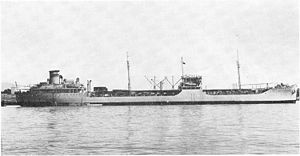Mission Buenaventura-class oiler: Difference between revisions
imported>Robert A. Estremo m (links) |
imported>Robert A. Estremo m (move image) |
||
| Line 77: | Line 77: | ||
*[[USNS Mission Purisima (T-AO-118)|USNS ''Mission Purisima'' (T-AO-118)]] | *[[USNS Mission Purisima (T-AO-118)|USNS ''Mission Purisima'' (T-AO-118)]] | ||
*[[USNS Mission San Antonio (T-AO-119)|USNS ''Mission San Antonio'' (T-AO-119)]] | *[[USNS Mission San Antonio (T-AO-119)|USNS ''Mission San Antonio'' (T-AO-119)]] | ||
*[[USNS Mission San Carlos (T-AO-120)|USNS ''Mission San Carlos'' (T-AO-120)]] | *[[USNS Mission San Carlos (T-AO-120)|USNS ''Mission San Carlos'' (T-AO-120)]][[Image:Mission Buenaventura-class oilers.jpg|thumb|right|300px|{{Mission Buenaventura-class oilers.jpg/credit}}<br />''Mission Buenaventura''-class oilers (from left to right) ''Mission De Pala'', ''Mission Solano'', ''Mission San Carlos'', ''Mission San Luis Rey'', and at least two additional sister ships undergo outfitting at Marinship, date unknown.]] | ||
*[[USNS Mission San Diego (T-AO-121)|USNS ''Mission San Diego'' (T-AO-121)]] | *[[USNS Mission San Diego (T-AO-121)|USNS ''Mission San Diego'' (T-AO-121)]] | ||
*[[USNS Mission San Fernando (T-AO-122)|USNS ''Mission San Fernando'' (T-AO-122)]] | *[[USNS Mission San Fernando (T-AO-122)|USNS ''Mission San Fernando'' (T-AO-122)]] | ||
| Line 95: | Line 95: | ||
*[[USNS Mission Soledad (T-AO-136)|USNS ''Mission Soledad'' (T-AO-136)]] | *[[USNS Mission Soledad (T-AO-136)|USNS ''Mission Soledad'' (T-AO-136)]] | ||
*[[USNS Mission Santa Ana (T-AO-137)|USNS ''Mission Santa Ana'' (T-AO-137)]] | *[[USNS Mission Santa Ana (T-AO-137)|USNS ''Mission Santa Ana'' (T-AO-137)]] | ||
==Notes== | ==Notes== | ||
{{reflist|2}} | {{reflist|2}} | ||
Revision as of 00:21, 10 June 2013
 USNS Mission Buenaventura prepares to USNS Mission Buenaventura prepares toget underway, date and location unkown.[1] | |
| History | |
|---|---|
| Preceded by: | Cimmaron class |
| Built: | 1943–1945 |
| Planned: | 29 |
| Completed: | 27 |
| Converted: | 4 |
| Lost: | 2 |
| Scrapped: | 25 |
| In commission: | 1944–1980 |
| Succeeded by: | Suamico class |
| General Characteristics | |
| Hull type: | T2-SE-A2 / T2-SE-A3 |
| Displacement: | 5,532 tn light; 21,880 tn full |
| Length: | 524 ft (160 m) |
| Beam: | 68 ft (24 m) |
| Draft: | 30 ft (9.0 m) |
| Speed: | 16.5 kt (31 km/h) |
| Complement: | 52 |
| Propulsion: | Turbo-electric, single screw, 6,000 hp |
| Armament (as-built): | None |
The Mission Buenaventura class was a series of twenty-seven T2 tankers built during World War II by Marinship of Sausalito, California under contract to the United States Maritime Commission for use by the United States Navy as fleet oilers. Two additional vessels were converted to distilling ships in 1944, after their keels were laid. All ships in the class were named after Spanish colonial settlements located in the present-day state of California save for USNS Mission Loreto which was named for a settlement in Baja California Sur, Mexico. Operating under civilian charter through 1946, the ships were transferred to the Naval Transportation Service (NTS) in 1947-48 and then to the Military Sea Transportation Service (MATS) in 1949. Two vessels were lost at sea: Mission San Francisco broke in two and sank with the loss of ten souls following a collision with the Liberian freighter Elna II while passing New Castle, Delaware on March 7, 1957, and Mission San Miguel ran aground on Maro Reef in the Hawaiian Islands on October 8, 1957.
In early 1960 Mission Capistrano was converted to a "Sound Testing Ship" wherein she was modified to carry an ultra‑high‑powered sonar transducer array and reclassified USNS Mission Capistrano (AG‑162). Upon completion of her conversion she was placed in service as USNS Mission Capistrano (T-AG-162) and joined "Project ARTEMIS," a program intended to ultimately produce a system that could detect submarines at long range. In 1964 three Mission Buenaventura class ships were subsequently converted to "Missile Range Instrumentation Ships" and played vital roles in America's manned space flight programs: Mission De Pala was redesignated as USNS Johnstown (AGM-20) but less than six months later had her name changed to USNS Redstone (T-AGM-20); Mission San Fernando was reclassified as USNS Muscle Shoals (AGM-19), then renamed USNS Vanguard (T-AGM-19) the following year; and finally, Mission San Juan, initially renamed USNS Flagstaff (AGM-21), ultimately bore the moniker USNS Mercury (T-AGM-21). Eleven of the class served out their final days hauling cargo in various forms for civilian shipping companies.
List of vessels
- USNS Mission Buenaventura (T-AO-111)
- USNS Mission Capistrano (T-AO-112)
- USNS Mission Carmel (T-AO-113)
- USNS Mission De Pala (T-AO-114)
- USNS Mission Dolores (T-AO-115)
- USNS Mission Loreto (T-AO-116)
- USNS Mission Los Angeles (T-AO-117)
- USNS Mission Purisima (T-AO-118)
- USNS Mission San Antonio (T-AO-119)
- USNS Mission San Carlos (T-AO-120)
- USNS Mission San Diego (T-AO-121)
- USNS Mission San Fernando (T-AO-122)
- USNS Mission San Francisco (T-AO-123)
- USNS Mission San Gabriel (T-AO-124)
- USNS Mission San Jose (T-AO-125)
- USNS Mission San Juan (T-AO-126)
- USNS Mission San Luis Obispo (T-AO-127)
- USNS Mission San Luis Rey (T-AO-128)
- USNS Mission San Miguel (T-AO-129)
- USNS Mission San Rafael (T-AO-130)
- USNS Mission Santa Barbara (T-AO-131)
- USNS Mission Santa Clara (T-AO-132)
- USNS Mission Santa Cruz (T-AO-133)
- USNS Mission Santa Ynez (T-AO-134)
- USNS Mission Solano (T-AO-135)
- USNS Mission Soledad (T-AO-136)
- USNS Mission Santa Ana (T-AO-137)
Notes
- ↑ (PD) Photo: United States Navy
